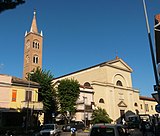Cattolica
| Cattolica | ||
|---|---|---|

|
|
|
| Country | Italy | |
| region | Emilia-Romagna | |
| province | Rimini (RN) | |
| Local name | Catòlga | |
| Coordinates | 43 ° 57 ' N , 12 ° 44' E | |
| height | 12 m slm | |
| surface | 6 km² | |
| Residents | 17,098 (Dec. 31, 2019) | |
| Population density | 2,850 inhabitants / km² | |
| Post Code | 47841 | |
| prefix | 0541 | |
| ISTAT number | 099002 | |
| Popular name | Cattolichini | |
| Patron saint |
San Pio V (April 30th) |
|
| Website | Cattolica | |
 Cattolica on the Adriatic |
||
Cattolica is an Italian seaside resort with 17,098 inhabitants (as of December 31, 2019) on the Adriatic Riviera in the province of Rimini in Emilia-Romagna .
geography
Cattolica is 23 kilometers southeast of Rimini . The neighboring municipalities are Gabicce Mare , Gradara , Misano Adriatico and San Giovanni in Marignano .
history
The Roman settlement was originally built on the ancient Via Flaminia road . The name Cattolica was given to the area south of Rimini in a dispute between Catholic bishops and followers of Arianism around the Council of Rimini , 359 AD.
Archaeological excavations have shown that the local economy was based on doing business with the people who passed through. The area was both a transit station for travelers on the Bologna - Ancona - Rome route and for the pilgrims who went to Loreto or San Pietro.
Around 1500 the city had more than twenty well-known taverns and inns. The business with the inn was supplemented by fishing in the middle of the 19th century . As a result, the age of tourism was heralded in Cattolica . One of the first known people to appreciate the beach of Cattolica was Luciano Bonaparte , brother of Emperor Napoleon , who in 1823 preferred Cattolica to the then more sophisticated Rimini.
When the Bologna – Ancona railway went into operation in 1861 , many wealthy families from Emilia-Romagna had their summer residences built there. After the First World War tourism flourished again. The place was no longer a destination for noble guests, but above all for the middle class . As early as the 1930s, Cattolica was a tourist destination that was known throughout Europe. Many mansions have been converted into elegant hotels to accommodate the crowds that drove millions of room nights a year in the 1950s and 1960s.
Attractions
- La Rocca : Built in 1491 to protect residents' property in the event of a Turkish invasion. It was the seat of the Capitano di Cattolica , chosen by the Rimini Council to protect the Borgo . It is now privately owned.
- Chiesa di Sant'Apollinare : The church was probably built towards the end of the 12th century, although it was officially mentioned for the first time in 1313. The last renovation was in 1782.
- Galleria Comunale Santa Croce : The former church of Santa Croce was built towards the end of the 16th century next to the pilgrims' hospital .
- Theater: an all'italiana theater (700 seats) designed by the architect Pierluigi Cervellati.
- Centro Culturale Polivalente: library, antiquarium (Roman objects from archaeological excavations), seafaring department with documents and materials on the history of seafaring
- Archaeological excavations: remains of a house from Roman times
- Le Navi theme park (saltwater aquarium)
Town twinning
Cattolica lists the following eight partner cities :
sons and daughters of the town
- Mariano De Nicolò (1932–2020), Roman Catholic Bishop of Rimini
- Marco Simoncelli (1987-2011), motorcycle racer
- Niccolò Antonelli (* 1996), motorcycle racer
Web links
Individual evidence
- ↑ Statistiche demografiche ISTAT. Monthly population statistics of the Istituto Nazionale di Statistica , as of December 31 of 2019.
- ↑ Relazione Previsionale E Programmatica 2012/2014 - p. 47. Accessed April 30, 2017 .







